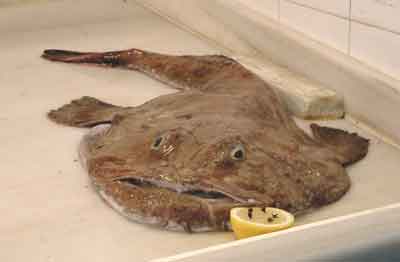"Martin goose." A festival at which roast goose is eaten. Martin was a monk who lived in Tours and who was so beloved that the people wished him to become a bishop, an honour which he wished to forego. He concealed himself amongst a flock of geese - not the most obviously discreet place I would have thought - and, inevitably, the geese became flustered and revealed his presence. His revenge was to eat a roast goose on the anniversary of this event, 10th November, called Mårtens afton in Sweden. The tradition spread far and wide and is particularly celebrated in the Skåne province of southern Sweden.

Monkfish (US: angler fish). A fish with a sweet flavour and succulent firm flesh but with the ugliest appearance imaginable. It is found in the Mediterranean and Atlantic, in coastal waters of north western Europe. It can be recognised by its large head and fan-shaped fins. The fins and the operculum are spiny. It can be eaten fried or in soup. The larger fish often have better flavour. It has a hideous head, which is why it is usually displayed without it, and a muddy colour. It is known as the anglerfish as it bears on its head a 'rod' and 'lure' which attract its prey. The meat of the tail is sweet and succulent - almost like lobster meat, entirely compensating for is appearance. The flavour may well be assisted by its own diet which is high in shellfish. The best monkfish are Lophius piscatorius and the similar Lophius budegassa, the favourite of the Spanish. American monkfish or goosefish (Lophius americanus) is considered inferior, while New Zealand monkfish (Kathetostoma giganteum) is related to the stargazer and is only fit for soup.
Muskellunge, from the Ojibwa, or muskie. A large, freshwater relative of the pike from North America. It is quite uncommon.